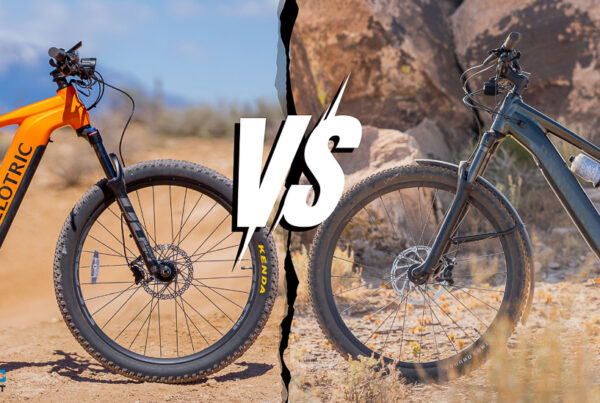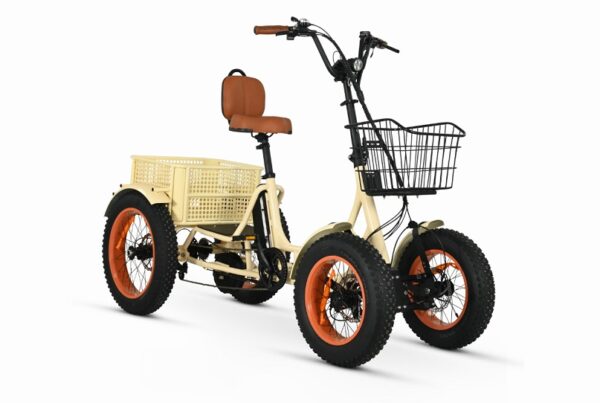Some links may be affiliate links. We may get paid if you buy something or take an action after clicking one of these.
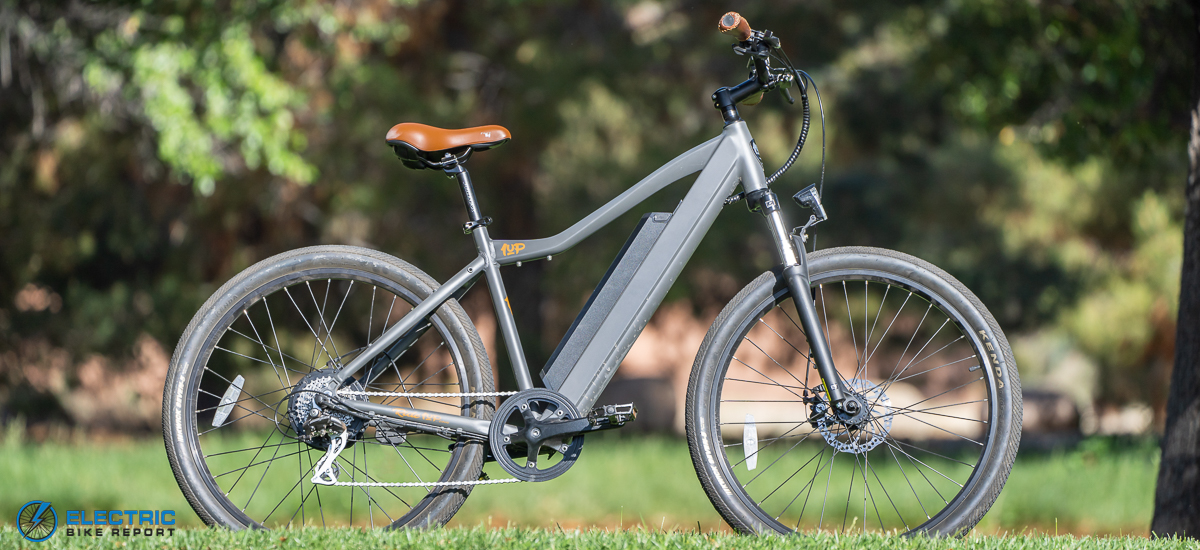
Summary Review: Ride1UP 500 Series Electric Bike
An old problem reared its head while we were reviewing the Ride1UP 500 Series: Electric bikes are just really tough to sort into categories.. There’s just too many ways you could feasibly use an e-bike — or too many opinions chiming in — to neatly parse out who and what exactly a particular bike is best for. But by golly we try.
That’s why this review of the Ride1UP 500 Series was a bit tough to write. When the Electric Bike Report team sat down to debate how we’d describe this bike and define who exactly it was for, we hit a wall. Despite our different backgrounds and areas of expertise in the bicycling world — from racing to weekend path cruising and everything in between — we all really liked the 500 Series. Usually, there’s at least one among us who’s a detractor. Not this time.
The 500 Series is a comfort commuter at heart, but in reality it’s just a really good all-around e-bike for the money. It’s comfortable, sporty enough to throw around, has good battery life and doesn’t pretend to be some newfangled take on an eMTB or electric folder. We’re not trying to claim it’s perfect — we’ve got some gripes with the cadence sensor and battery readout that I’ll get into later — but you’ll be hard pressed to find a more versatile and well decked comfort e-commuter at this price
Our testers with a racing background liked how stable the bike felt at speed, and our testers that look for commutability appreciated its surprising range and comfort during longer stints in the saddle. Everyone, no matter their background, liked the 500 Series’ mellow yet satisfyingly torquey 500W motor.
Add this all together, and Ride1UP has given you a solid option for anyone looking for one bike that can wear many different hats and won’t break the bank.
Bike Category:Commuter/Cruiser: It’s a commuter e-bike with a laid-back geometry that’s similar to the body position on a cruiser
Bike Class: [Class 1, 2, or 3] Class 2/Class3: Throttle assist up to 20 mph and pedal assist up to 28 mph
Ride1UP 500 Series Video Review
 Pro’s
Pro’s- Battery range exceeded expectations. The 624Wh battery powered the 500W motor for a solidly long distance
- The 8-speed Shimano Acera drivetrain is awesome, especially at this price point. Bonus points for the under-bar thumb shifter pod
- Though the power delivery at first is tame and controlled, it’s a surprisingly quick bike — especially on higher PAS settings. We never had a problem holding close to the bike’s max motor-assisted speed of 28 mph
- Ride1UP balanced comfort and sportiness well with this one. It’s a pleasant ride that doesn’t trade efficiency for an overly upright position
- Overall, there’s lots of bang for your buck: Good components, good motor and good looks for around $1,300
 Con’s
Con’s- There’s a noticeable lag before the motor stops applying power after you stop pedaling. This is controllable with the brake-activated kill switches, but worth keeping in mind
- The battery readout isn’t super accurate and says the battery is more empty than it really is. But we’ll take a conservative readout over one that overpromises
ELECTRICAL SPECS & FEATURES
- Battery: 48V 13Ah (624Wh) Reention Dorado ID Plus with LG cells and a smart battery management system
- Display: KD21C LCD
- Motor: 48V geared rear Shengyi hub motor | 500W nominal rating
- Headlight: LED headlight, operated from the display
- Taillights: None
- Peal Assist: Five pedal assist settings operated by a 12 magnet cadence sensor
- Range: 25 to 45 miles, claimed by Ride1UP
- Throttle: Thumb actuated on the left side of the handlebars
Weight & Dimensions
- Battery weight:
- Total bike weight: Claimed: 55lbs | Actual: 57.09lbs
- Maximum rider weight: 275 lbs
- Maximum load on rear rack: N/A
- Unfolded Dimensions: N/A
- Folded dimensions: N/A
Components & Accessories
- Brakes: Tektro Aries mechanical disc
- Fenders: None
- Fork: Suntour XCT coil spring, 100mm travel
- Frame: 6061 aluminum alloy
- Drivetrain: Shimano Acera 8-speed | 44t chainring and 11-30t cassette
- Grips: Stitched faux leather
- Handlebar: Aluminum riser bars
- Kickstand: Included, chainstay mounted
- Pedals: Wellgo alloy
- Tires: Kenda Kwick Seven.5, 27.5”x2.2”
Performance Review: Ride1UP 500 Series
Acceleration / Speed
The 500 Series isn’t the quickest e-bike off the line, but it’s not meant to be.
Instead, this bike delivers its power very tamely at first and then rolls on the gas as you pick up speed. This effect makes the 500 Series a very manageable and smooth bike. Never once does the bike feel like it wants to come out from underneath you, even in high motor assistance settings.
But that does not mean it’s slow. The 500 Series has no problem accelerating to its maximum motor assisted speed of 28 mph. Its throttle is also surprisingly powerful and many of our testers reported it held steady at it’s 20 mph throttle-assisted limit with no issue. The 500W geared rear hub motor isn’t the torquiest and will slow gently on long or steep hills, but it will get you over the top without requiring much input from the rider. Even the biggest and torquiest e-bike motors we’ve reviewed slow down on hills — gravity is a thing, you know.
This bike is a mix of Class 2 and Class 3. It has a throttle that will operate until you reach 20 mph, and you can engage the motor up to 28 mph by pedaling.
Range Test
I’m still recovering from the sunburn I got while range testing the 500 Series.
Summer is fast approaching here in southern Utah, so I rolled out from the EBR offices with a liberal layer of sunscreen smeared on myself. But thanks to the 500 Series’ seriously impressive battery life, my wimpy SPF 80 was no match for the sheer amount of time it took to make the bike die.
On the maximum assist level, the 500 Series went for 27.12 miles at an average speed of 19.4 mph before running out of battery. A great result that modestly outpaced Ride1UP’s claimed range of 25 miles, but nothing too unexpected. We always get excited when a value-priced bike exceeds our range expectations, but it wasn’t until the low-power test that we really got the full picture of just how far the 500 Series could go on a single charge.


Boy howdy did it go a long way. On PAS 1, pedaling at a talking pace as if we were commuting to work or the store, the 500 Series lasted a whopping 67.36 miles before the battery died. It took so long to do this test, we actually had to split it between two days. Josh, a local high school-aged mountain biker who helps us with long range tests, knocked out 41.95 miles the first day and I did the remaining 25.41 miles the next. This is a seriously impressive result that goes screaming by Ride1UP’s claimed max range of 45 miles. It took us a combined 5:09:44 seconds to complete the test, and cost me at least a week of dealing with a painful sunburn. The average speed on PAS 1 was pretty slow — combined we averaged 13.04 mph — but that’s expected at the lowest power level.




One thing of note about the 500 Series, is that the battery indicator will show that you’ve drained the first half of your energy pretty quickly, then will seemingly go forever showing a half charge or less. The display shows power as a series of bars and on both of the range tests I did, for example, I logged the majority of the miles with just one or two bars of power left. This isn’t a huge deal and is something we see quite often on e-bikes (turns out it’s quite hard to accurately measure how long a battery will last in the real world), but is something to keep in mind. The good news is the display’s power reading is conservative and doesn’t overpromise how much juice is left in the tank. We’d much rather be pleasantly surprised by extra battery life than get stranded unexpectedly.
Circuit test
Around the EBR test circuit, a 1.04 mile loop with a small hill and no stop signs, the 500 Series had very noticeable differences between each of its power assistance levels (PAS levels).
This test informally demonstrates the bike’s average speed at each PAS level, plus the average speed of a lap with no motor assistance. We found there was a difference of 2.63 mph on average between each PAS level, a very good result considering there are some bikes with virtually no difference between power levels.
The EBR circuit test also gives us a good feel for the bike’s overall performance. In addition to this being the closest thing to a closed circuit we have, it’s got a small hill and each test is performed from a dead stop, so we get a feel for the bike’s acceleration too. Despite it’s comfort geometry, the 500 Series climbs and corners very well. It feels stable while pedaling and standing and it’s very predictable going around turns.
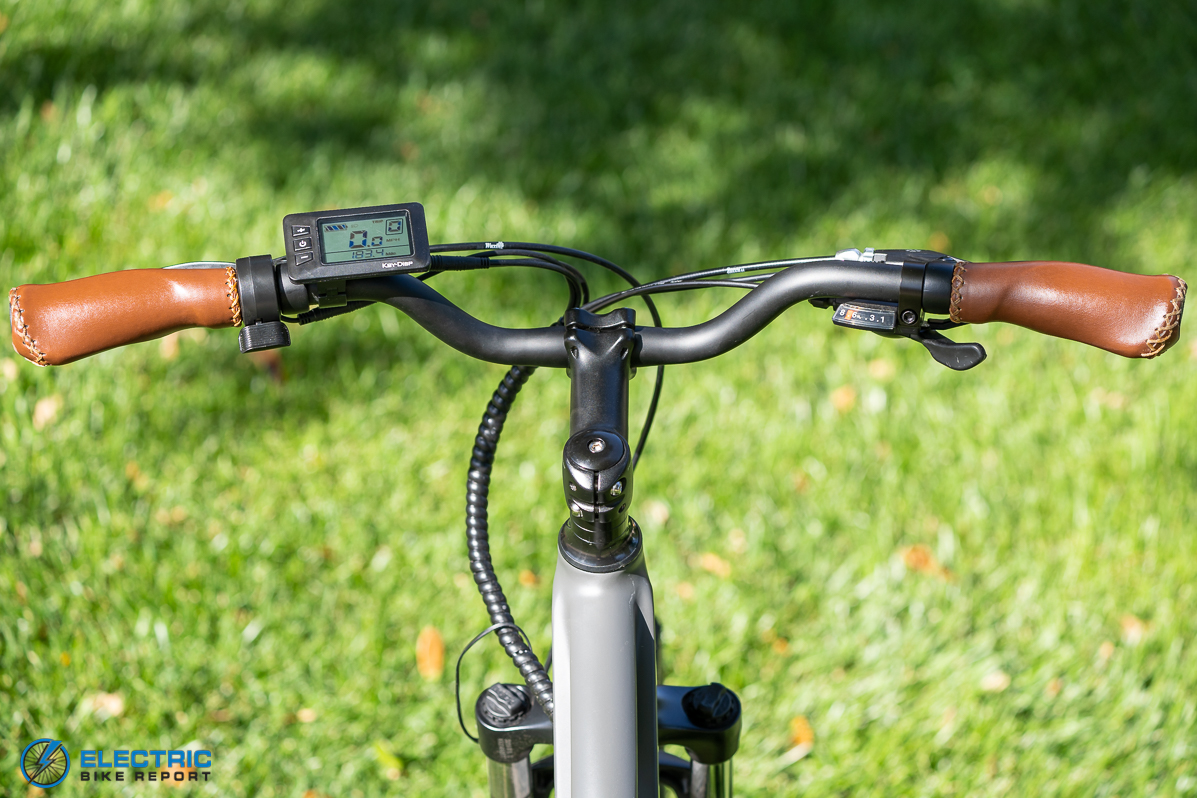
Ride1UP – 500 Series – Cockpit POV

Ride1UP – 500 Series – Thumb Throttle
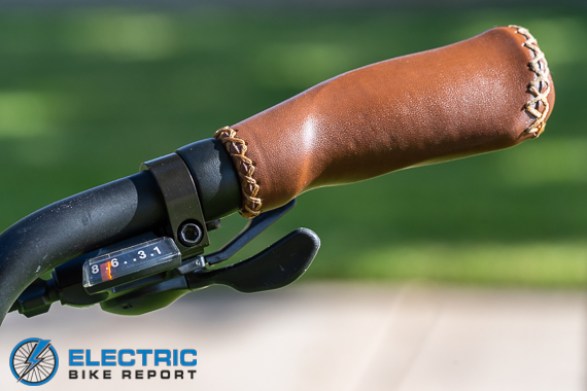
Ride1UP – 500 Series – Shimano Acera Shifter
Hill Test
Up hills, the 500 Series performed about how we expected. Rated at 60Nm of torque the motor isn’t some torque monster, but it had plenty of power to get to the top of our test hill. Which, it’s worth noting, is far steeper and longer than your average hill.
We ran the 500 Series up the hill twice, once on PAS 5 and once only using the throttle. Our test hill, lovingly called “Hell Hole” in St. George, pitches over 12 percent several times over it’s length. It’s enough to stress even the most powerful bikes.
On PAS 5, the 500 Series cruised up the hill with a time of 1:13:00, which is a really solid result. I was able to stay seated the whole time and the bike never felt overtaxed. But when we took my legs out of the equation and relied solely on the throttle, the 500W motor strained and slowed on some of the steeper pitches. Using just the throttle, the 500 Series got to the top in 2:43:00. It is not at all uncommon for test bikes to struggle up Hell Hole during the throttle-only test, so the Ride1UP’s performance is not at all out of line. I did resort to switchbacking back and forth on some of the steeper sections to give the bike a fighting chance. The bike did make it, but my lowest recorded speed did fall to about 1.2 mph — so probably slower than most people are comfortable riding with their feet up.
I give the 500 Series a lot of credit for how it performed on our test hill. Ride1UP does not claim it’s a mountain goat, and we’ve already noted it’s motor is more mellow than torquey, so the fact that it kept chugging is really impressive.
Handling (cornering, slow speeds, safety on bike, etc.)
Predictable, stable and easy to manage; these are ways our team of testers described the handling of the 500 Series.
The bike feels very planted, even at its top motor-assisted speed of 28 mph. It’s not built to be a hard-cornering racer, but you can whip it around corners with gusto if you’re feeling a little spicy. The second-to-last corner on our circuit test is always the moment our testers know, with puckering certainty, if a bike corners well or not. By the time I hit the apex of that turn during the max assist lap of the 500 Series’ circuit test, I was well over the bike’s max motor assisted speed of 28 mph and was able to make it through without touching the brakes.
It’s a comfortable bike, but by no means does that mean it’s slow.
Ride Comfort
We call bikes like the 500 Series a “comfort commuter;” it’s upright and comfortable, but the geometry is sporty enough that you can pedal it for long distances without feeling that you’re wasting lots of energy.
We liked all the bike’s contact points from the grips to the cushy seat, and the suspension fork plus the voluminous Kenda tires smoothed out most road vibration. There is a step-thru version of this bike with a shorter reach and more swept-back handlebars. We haven’t tested that version, but you can expect it to ride more similarly to an upright cruiser.
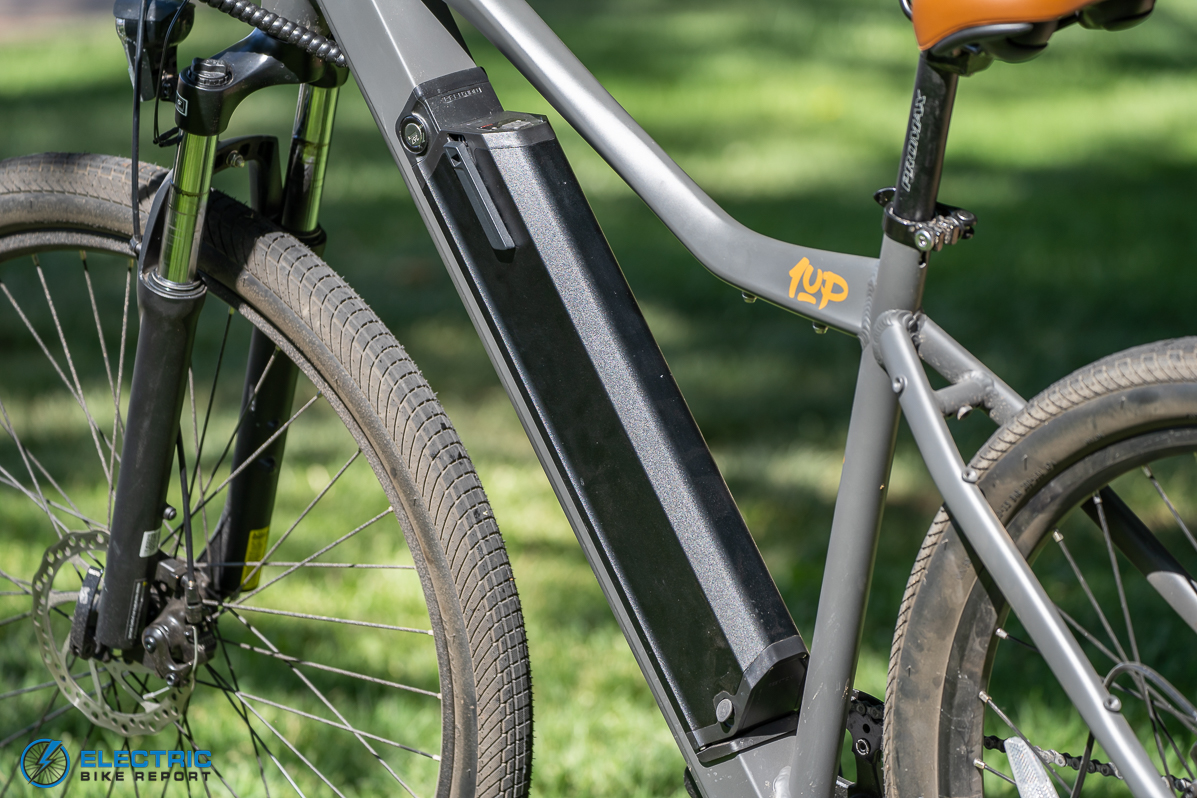
Ride1UP – 500 Series – Lithium Ion Battery
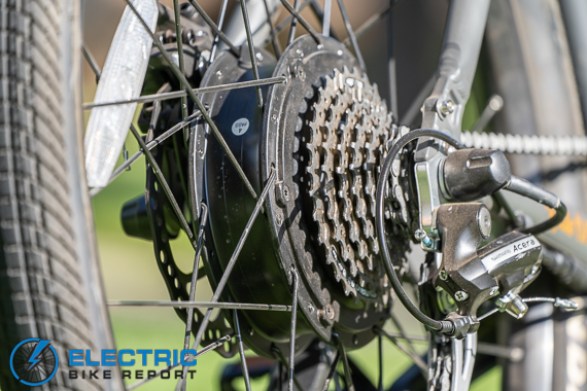
Ride1UP – 500 Series – Geared Hub Motor
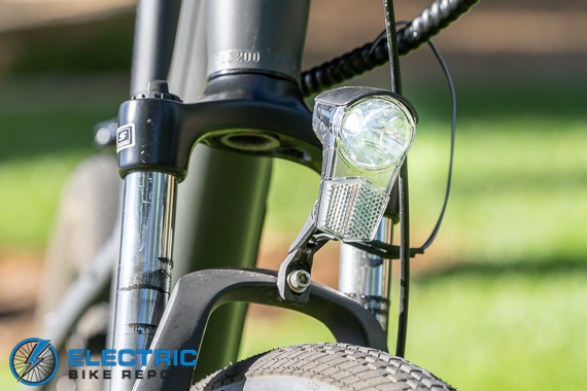
Ride1UP – 500 Series – Front Headlight
Ride1UP 500 Specs/Features: Electrical Components
Motor
The 500 Series’ motor is smooth, and feels very controlled when it kicks on. A problem we see quite often with value-priced e-bikes with motors as large as this one is that they have a “jumpy” sensation when the motor kicks on. This bike does not have that.
It’s power delivery is nice and predictable, giving the bike a mellower feel that doesn’t hamper a rider’s ability to take full advantage of the 500W motor. It’ll still get you up to it’s top speed quickly, just without you needing to white-knuckle the grips.
The Shengyi built rear hub unit is rated for 500W and Ride1UP claims it can peak briefly at 750W. It’s not the torquiest motor we’ve tested, but we don’t necessarily view that as a bad thing. The mellower torque makes the bike more manageable when it kicks on from a stop, and the motor still has plenty of oomph to get up hills.
Battery
The 48V 13Ah Reention Dorado ID Plus battery is made of LG cells and has a smart battery management system, a feature that keeps the cells balanced and functioning safely and efficiently. That battery has 624Wh of energy, which paired with the 500W motor, gives the bike a pretty good range. On paper — and in a lab-controlled setting without variables like weather, hills and a rider’s pedaling — this motor and battery combination should be able to run at full power continuously for 1.25 hours before it runs dead.
In the real world, I was able to ride the 500 Series for one hour and 24 minutes (1.4 hours) before it ran out of juice. This is right in line with what we’d expect from this battery with the addition of a rider pedaling and other outside variables.
Pedal Assist / Throttle
While we found the thumb throttle’s engagement crisp and responsive, the 500 series’ 12 magnet cadence sensor was slower engaging than we would have liked.
All of our testers reported a lag of one to two full rotations of the crank before the motor kicked on. This lag also affected the motor shutoff after our testers stopped pedaling, where we noticed the motor continued to apply power for several seconds after we started coasting.
The lag to get the motor going was not a huge deal to our testers, just something they got used to after a few miles on the 500 Series. But the lag in motor shutoff caught several of us off guard when entering corners or coasting in a low-speed area. It’s something easily controlled by the motor kill switches on the brakes, which kill power as soon as you pull either brake lever, but is something to keep in mind as the continued power isn’t something you expect when you stop pedaling.
Sensor lags are not unique among value priced e-bikes. In fact, it’s something our testers automatically expect on e-bikes below the $2,500 benchmark. Is it something companies can improve? Absolutely, which is why we’re noting it here. But we don’t think it’s something that detracts from the 500 Series, as we were overall really happy with the bike’s performance and ride feel. Just bear in mind that lag is there, especially on your first few outings. You’ll be used to it in no time.
Display
The black and white display is useful and utilitarian. It gives you a speed readout, tells you what motor assist setting you’re in, how much battery you’ve got left and keeps track of your total mileage on the bike. The three buttons allow you to cycle through the five PAS settings and turn the bike on and off easily.
Battery life is measured in black bars in the top left corner of the display. These indicators are chronically hard to decipher on nearly every e-bike we’ve tested, and the 500 Series is no exception. For us, the indicator dropped to less than half battery quickly and then went down much slower after that. During the maximum assist (PAS 5) range test, for example, the battery indicator depleted to less than half in the first 13 miles. I then rode another 14-plus miles with the indicator reading less than half battery capacity left.
This is a nitpicky detail from us, especially considering it’s an issue we see quite often. All things considered, we’d much rather have a battery readout that’s conservative versus one that promises more energy than the battery can deliver. Just keep in mind that you may have more juice left than what the readout says.
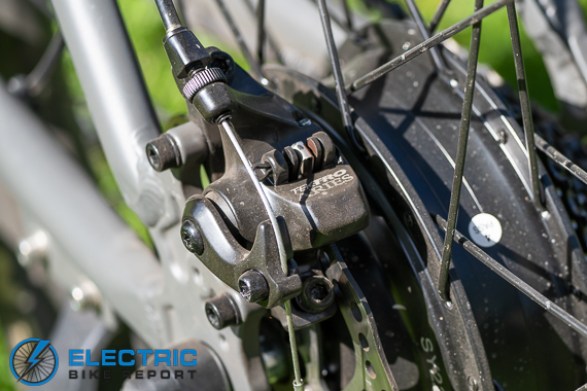
Ride1UP – 500 Series – Tektro Aries Brakes
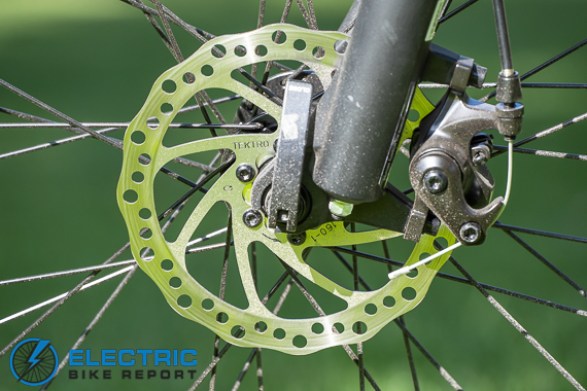
Ride1UP – 500 Series – Disc Brake Rotor
Ride1UP 500 Series: Components and Accessories
Brakes
The Tektro Aries mechanical disc brakes performed well and stopped quickly, which is extremely important considering the 500 Series has no problem reaching its top speed of 28 mph.
During the brake test, where we take the average of five full-power stops from 20 mph, the bike came to a stop very consistently and quickly. The results from the five runs were grouped tightly — each result was within a foot or less of the next one — which is a good indicator that the brakes are performing well. On average, the bike came to a stop in 16’2”, a result right in line with what we’ve seen from other bikes with mechanical disk brakes.
Bear in mind that mechanical brakes are a bit tough to tune correctly, so we highly suggest taking this e-bike to a bike shop to get it tuned professionally when it shows up at your door.
Frame
The 6061 aluminum frame gave the 500 Series a compliant and comfortable ride. I’m personally a fan of understated paint jobs — especially when it comes to branding — and this bike is about as understated as they come. It’s gunmetal grey with some very small Ride1UP logos on the chainstay, next to the seat tube and on the headtube.
We tested the high-step model, but you can also get it in a step-thru variation that makes it easier to get on and off of. The step-thru also has a slightly different geometry that makes the bike more upright and handlebars with more backsweep. Our model had tan accents in the Ride1UP logos, the seat and on the grips, but you can get one with black accents too.
Fork
The SR Suntour XCT coil spring fork is a workhorse suspension fork we see quite often on value-priced e-bikes. It’s a solid fork that takes the edge off pavement bumps and can handle some very light off-road use on dirt paths and roads.
It’s got 100mm of travel, which is more than plenty for this bike’s intended use, and has a lockout switch that’s easily accessible on top of the fork’s crown.
Drivetrain
The Shimano Acera groupset is a solid mid-level drivetrain designed to withstand the rigors of light mountain biking, so it’s an overbuilt (in a good way) and durable choice on a commuter like the 500 Series. It shifts crisp and the gearing options are broad enough to get you up most any hill.
But it’s not the durability or capable shifting that makes us love that Ride1UP spec’d the 500 Series with Acera. Don’t get me wrong, those things are great — but there’s another reason we really, really like this groupset: The shifter pod is underneath the handlebar, not on top of it. This means you can shift gears without unhooking your thumb from the handlebar.
There’s a simple reason why this seemingly benign design feature matters so much: It’s safer. Your thumbs wrapped around the back of the grips are the only surefire thing keeping your palms from sliding off the handlebars should you hit a bump that throws your momentum forward. It’s a safety feature you’ve likely never thought about unless you’ve experienced the displeasure of forcefully sliding off your grips, but it’s an important one in EBR’s eyes. It’s also just convenient; all you have to do is move your thumb an inch or so and it’s on the shift paddles.
Bonus points to the 500 Series for the configuration of its thumb shifter.
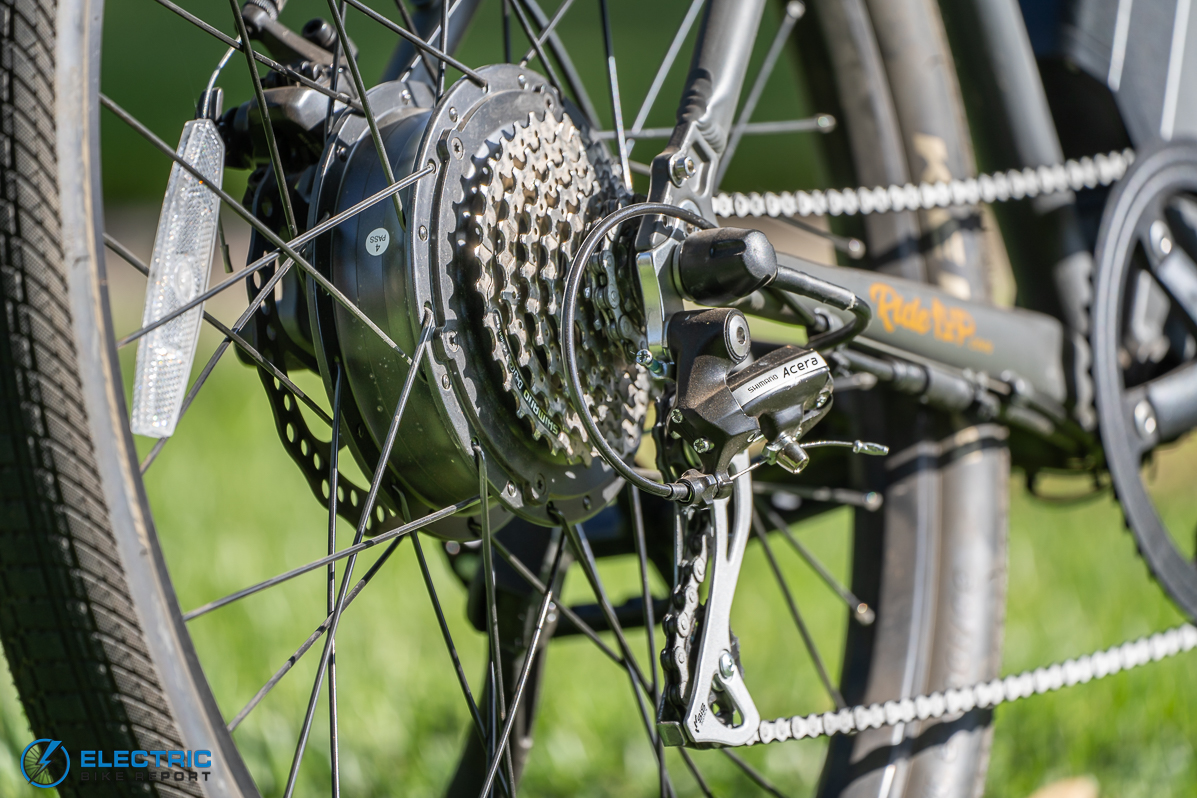
Ride1UP – 500 Series – Shimano Acera Drivetrain
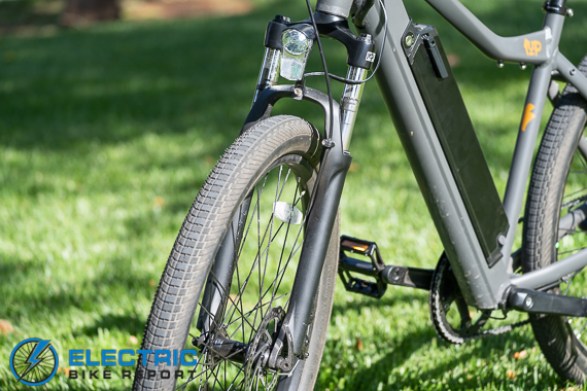
Ride1UP – 500 Series – Suntour Fork
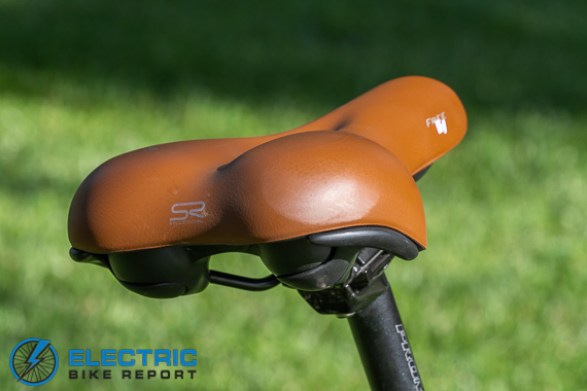
Ride1UP – 500 Series – Selle Royal Saddle
Contact Points
The handlebars on the high-step model are lowrise and have a gentle backsweep; not enough that the bike feels like a cruiser, but enough that it’s comfortable and relatively upright. The seat is large and cushy, and the pedals are made entirely of alloy so they’re super solid under your feet. The grips are a faux leather variation with stitching along the edges that look nice but can get a little slippery if you’ve got sweaty hands like me.
Overall, all the places your body contacts the bike feel comfortable and supportive.
Tires
The tires are a pair of Kenda Kwick Seven.5 semi-slick commuter tires that roll quick and grip very well. They’ve got puncture protection that’ll help prevent flats and a strip of reflective tape on the sidewall that makes you stand out in low-light conditions.
Extras / Accessories
Our model of the 500 Series was a spartan setup that only came with a front LED light, but for an additional fee you can choose a variation that comes with front and rear fenders and a rear pannier-style rack.
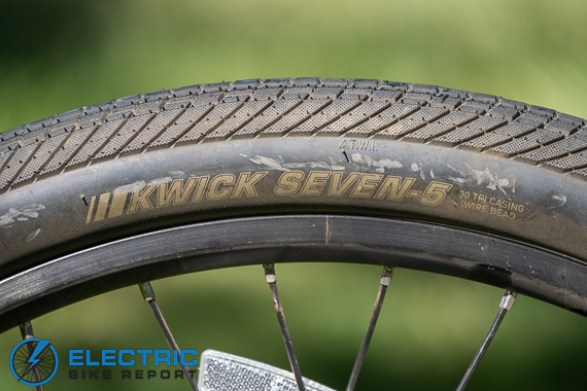
Ride1UP – 500 Series – Kwik Seven5 Tires
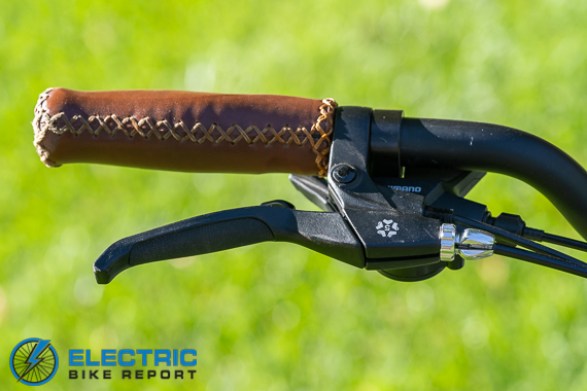
Ride1UP – 500 Series – Faux Leather Grips
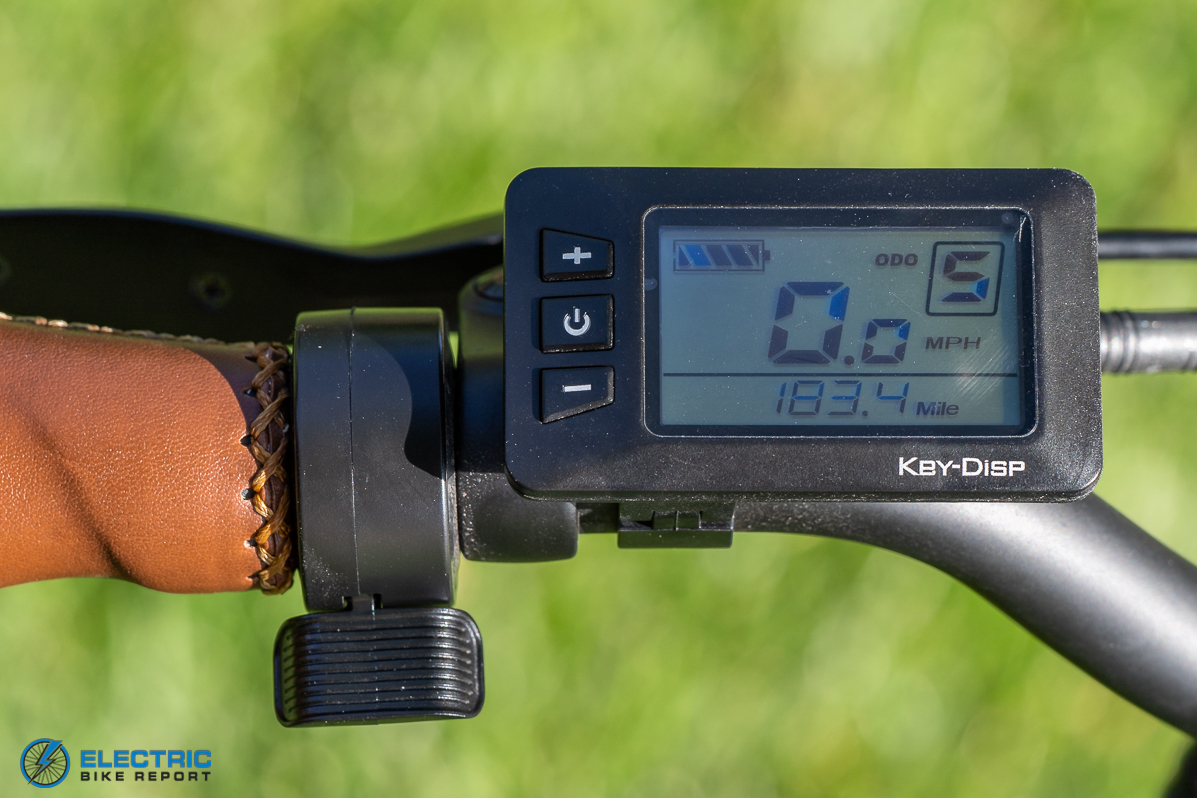
Ride1UP – 500 Series – LCD Display
Ride1UP 500 Series Summary Review / Where to Buy
Our Ride1UP 500 Series review impressed our testers and showed it’s a solid, affordable and versatile comfort commuter e-bike.
While it’s bread and butter is commuting on bike paths and city streets, we feel it’s a solid choice for anyone looking for a one-trick pony of an e-bike. It obviously has its limitations: it’s not going to perform well on dirt beyond some light-duty gravel paths and it is still a value-priced bike, so there are some issues we detailed above. But overall, it’s a lot of bike for the money.
Ride1UP is a direct-to-consumer company so you can buy the 500 Series on their website from the button above and have it shipped to your door. The bike shows up mostly assembled, but you will have to attach handlebars, the wheel and possibly the cranks. Like most bikes we test, we do highly suggest taking Ride1UP’s bikes to be professionally assembled or at least tuned up by your local bike shop. The 500 Series also comes in a step-thru variation and you can order one with stock fenders and a rear rack if you choose.
As always, we want to hear your feedback on our reviews and the bikes we test, so please consider leaving us a comment below.
Reader Interactions









